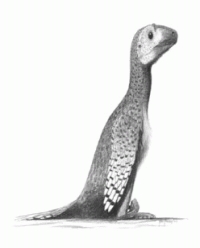Deinonychus Dinosaur Fun Facts
Table of Contents
A swift and vicious meat-eater, Deinonychus walked and ran on two feet, with a long stiff tail held out straight to help it balance its body. Smaller than many dinosaurs, it could grow to about 9 to 11 feet long.
- Its name means “terrible claw,” because one of its most distinctive features is the long, sickle-shaped claw on each of its feet that it most likely used to grab and possibly slash open its prey.
- Deinonychus had large, serrated teeth that curved backward, probably to help the teeth cut more easily through the meat of its prey.
- Deinonychus probably hunted in packs, leaping and kicking to subdue larger prey.
An animatronic Deinonychus at Chicago Brookfield Zoo measures 12.21′ long x 1.65′ wide x 4.95′ tall.
Origins & Name
Deinonychus, which in Greek translates into “terrible claw,” was a brutal predator that lived during the early part of the Cretaceous period. It was small in comparison to other dinosaurs and is comparable in size to a Jaguar. It is a type of dromaeosaurid and lived in modern-day Montana.
Physical Features
Deinonychus has a pair of large talons which are shaped like a sickle on each second toe. The talon could probably be retracted while the dinosaur moved, and at one time many paleontologists believed that this species used its talons to slash open the flesh of its prey. However, new studies and tests using velociraptors with similar claws reveal that Deinonychus stabbed its prey instead of slashing it.
 This species of dinosaur has strong tendons on its tail which give it balance and the ability to turn quickly. When looking at pictures of this dinosaur, it appears that it is a type of bird. Dromaeosaurids are very similar to birds and are a part of the raptor family. They are small to medium in size, and they walk on their hind legs.
This species of dinosaur has strong tendons on its tail which give it balance and the ability to turn quickly. When looking at pictures of this dinosaur, it appears that it is a type of bird. Dromaeosaurids are very similar to birds and are a part of the raptor family. They are small to medium in size, and they walk on their hind legs.
Deinonychus is a predator that uses speed and agility to overwhelm its prey rather than using brute force. John Ostrom was the first paleontologist to name the animal, and he believed that some if not all dinosaurs may have been warm-blooded instead of cold-blooded. It was also Ostrum who developed the hypothesis that birds may be the descendants of dinosaurs.
Similar species have been found in China, and Deinonychus no doubt had feathers. A skeleton of this dinosaur can be seen at the American Museum of Natural History. Deinonychus weighed approximately 175 pounds and stood at about 4 feet tall. They are closely related to the Velociraptors. The teeth of Deinonychus have been found next to the fossils of Tenontosaurus, and this is evidence that Tenontosaurus was hunted by this species.
While this dinosaur was small, it probably made up for this with enhanced speed and flexibility. It could probably spring upon its prey quickly, and use its talons to stab into the body of the prey, puncturing vital organs that would cause it to die in a short period of time. Because Deinonychus is related to the Velociraptor, many believe that it hunted in packs much like them.
While this makes logical sense given their small size, at this time it has not been proven or disproven whether Deinonychus or Velociraptors hunted in packs.
